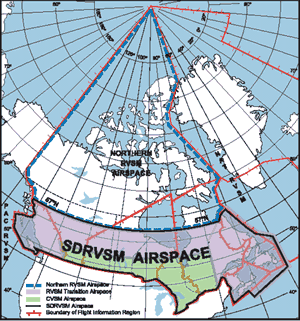
 GET USED TO THE TERM Reduced Vertical Separation Minimum, or RVSM. If
GET USED TO THE TERM Reduced Vertical Separation Minimum, or RVSM. If
the plans of the FAA and Nav Canada go forward as stated, RVSM will be
an accepted standard across all Canadian and US airspace in the very
near future.
RVSM
is a reduced vertical separation minimum of 1,000 ft from FL 290 and FL
410 inclusive between aircraft that meet the minimum aircraft system
performance specification (MASPS). In its simplest from, it means less
vertical separation between aircraft that are specially equipped to
operate accurately under these conditions – resulting in additional
available Flight Levels for ATC and accordingly more airspace capacity.
RVSM was first introduced on the North Atlantic routes in 1997.
Canada
implemented RVSM (FL 290 – FL 410 inclusive) in Northern airspaces last
April. According to Nav Canada, the program has been effective in
reducing fuel requirements, enabling other operational improvements,
and generating estimated savings of $14.3 million for operaters in 2002
alone.
To address both the current and projected capacity issues
of airspace and aircraft movements, the FAA announced its intention
last year to implement Domestic Reduced Vertical Separation Minimums
(DRVSM) from FL 290 to FL 410 by January 20th 2005.
The reaction
from the aviation community has been mixed, with some avionics
equipment manufacturers and numerous mod shops indicating that they
simply cannot get all the affected aircraft modified for RVSM
compliance by the planned date.
Despite the protests, the FAA is
moving forward with its DRVSM plans at full pace and has indicated that
they do not plan a phased introduction, as was the case in Europe. Nav
Canada is following suit and planning a concurrent implementation from
FL 290 to FL 410 in Southern Canadian Domestic Airspace – hence the
term SDRVSM. Nav Canada is committed to a harmonized implementation
date with the FAA. If the FAA pushes back that date, Nav Canada will
likely push back.
Nav Canada plans to consult extensively with
stakeholders and customers before SDRVSM becomes reality. As a first
step in the Eastern Region, Nav Canada, working with the CBAA, held an
information and discussion session in Toronto on November 21, 2002.
Sponsor of the event was Mid-Canada Mod Center, with participation from
Rockwell Collins whose ProLine 21 series has been specifically designed
to meet DRVSM needs on many older corporate aircraft.
Don
MacKeigan is the SDRVSM project manager for Nav Canada and was one of
the key presenters at the Toronto seminar. He noted that SDRVSM will
eliminate the current RVSM Transition airspace in Canada. It will also
provide a common interface with the adjacent US RVSM airspace, NAT RVSM
airspace and PAC RVSM airspace. The line of delineation at 57:00N will
disappear – creating continuous RVSM airspace from the North Pole to
Canada/US border. Flight planning for Canadian DRVSM will use a ‘W’
suffix to indicate RVSM approval.